Czechoslovakia at EXPO 67 in Montreal
Vladimíra Büngerová about Slovak participation in the Czechoslovak presentation at the 1967 Expo in Montreal
The exhibition and publication titled Brussels Dream that focused on the Czechoslovak participation in the Brussels EXPO in 1958[1] is followed by the research of the forthcoming national presentation of Czechoslovakia at the World’s Fair in Montreal in 1967. Among the reasons is a demand for documentation of the topic, but also the aim to critically revisit this historical event related with the art history and cultural policy of the former Czechoslovakia. The project covering Expo 67 in Montreal entitled The Exhibition Machine. The Czechoslovak pavilion at EXPO 67 in Montreal [2] stemmed from the cooperation of Daniela Kramerová (a co-curator of the exhibition and editor of the publication on Brussels Expo 58) and Terezie Nekvindová who studied the topic in her PhD thesis.[3]
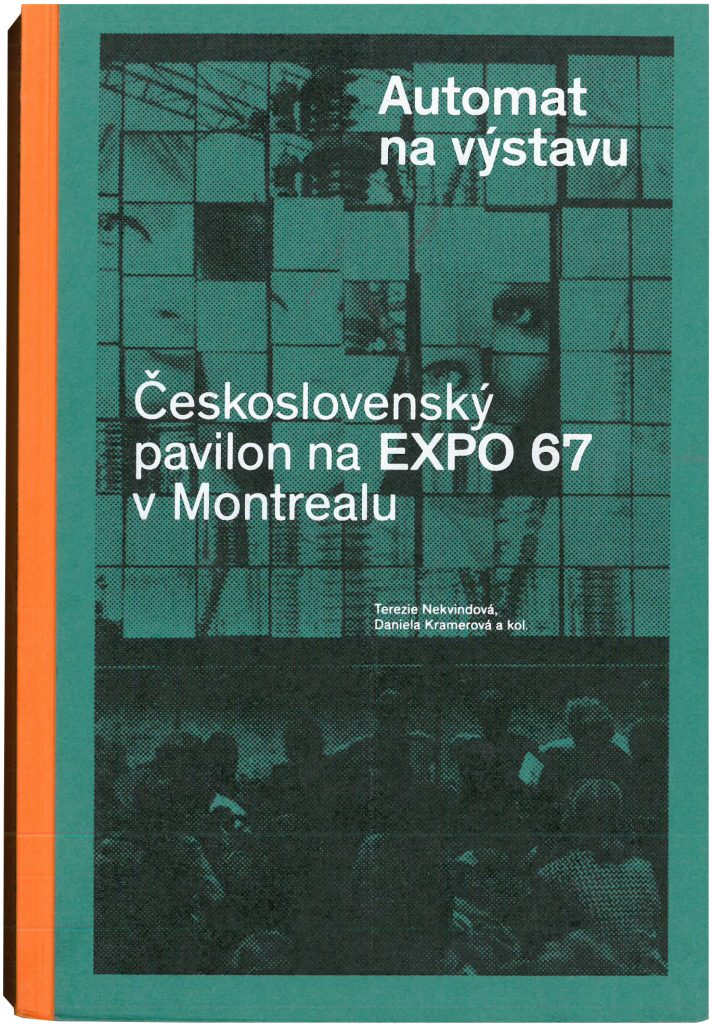
Cover of the book Daniela Kramerová a Terezie Nekvidnová: Automat na výstavu: Československý pavilon na Expo 67 v Montrealu. Akademie výtvarních umění, Praha; Galerie výtvarného umění v Chebu. 2017
The first exhibition was held at the beginning of November 2017 in The Art Gallery in Cheb. Then it will take place from 24th November 2017 to 18th March 2018 in The Museum of Applied Arts in Brno and the third show is scheduled for the period of 12th April to 20th June 2018 in the exhibition premises of The Satelit Slovak Design Centre in Bratislava.
One of the outcomes of the project was publishing the first monograph on Montreal’s Expo 67 which included expert analyses of several Czech and Slovak authors along with the documentation part mapping the Czechoslovak pavilion in Canada. Like in the case of the participation in Brussels, the book goes beyond the idea of a traditional exhibition catalogue and views the Czechoslovak participation in the World’s Fair from different aspects – cultural, artistic, national, political and social: Terezie Nekvindová: The Height of Exhibition Practice; Daniela Kramerová: Czechoslovakia at the World’s Fairs in Brussels and Montreal. From Legendary Beginnings to Functional Exhibition Machine; Henrieta Moravčíková: What was Missed Out at Expo. The Czechoslovak Architectural Technicism in the Context of the World Exhibition in Montreal; Martin Strakoš: Sobriety and Deliberateness May Be Our Strength… The Architecture of the Czechoslovak Pavilion at Expo 67 in Montreal; Martin Bernátek: The Spectacles of Synchronisation. The Czechoslovak Audiovisual Projects at Expo 67 in Montreal; Vladimíra Büngerová: Shepherd’s Hut on the Island. The Slovak Participation in Expo 67 in Montreal; Marta Sylvestrová: The Exhibition on Exhibitions; Pavel Sterec: Commentary on Artists’ Intervention in Exhibition.
Overview of Slovak Participants in the Pavilion and Restaurants of the Czechoslovak Socialist Republic (CSSR) in Montreal
The authors of the pavilion (František Cubr, Josef Hrubý, Zdeněk Pokorný) considered it their main responsibility to achieve an artistically unified environment – to make one compositional whole in terms of art and architecture. The Rudolf Uher’s Bilateral Relief was placed in front of the pavilion entrance. The sculptor portrayed an impression of movement on a horizontal relief with openings and elementary natural signs in the minimalist, reduced shapes. The CSSR state symbol standing on the pylon placed presumably in the entrance part (vestibule) was made using welding technique by sculptress Erna Masarovičová. The Hall of Centuries showed the stages of historical evolution of Czechoslovakia. Here, Slovakia was displayed by the exhibits from the beginnings of the settlement in the area of today’s Slovakia and artworks of gothic culture: the gothic monstrance from Spišská Nová Ves town, wooden sculpture of Virgin Mary of Ulož and a copy of The Last Supper by Master Paul of Levoča. The tapestry based on the design of the now-forgotten painter Juraj Krén entitled Maple and Lime Tree was also installed in this section; it was to illustrate the Czechoslovak-Canadian relationship symbolised by their “national trees”. Ľudovít Fulla devised a special design of an abstract monumental mosaic for the section named Traditions. It comprised four fields associated with different sources of inspiration of folk origin. The second mosaic in this section was based on the Milan Laluha’s painting Three Men, but in a black-and-white version, referring more to his pencil drawings than to his painting famous for its bright colours and dynamic depiction. Near the Laluha’s mosaic was, alongside a selection of historical glassware, a collection of contemporary glassware made by Slovak designers Karol Hološka a Jaroslav Taraba from Lednické Rovne glassworks.
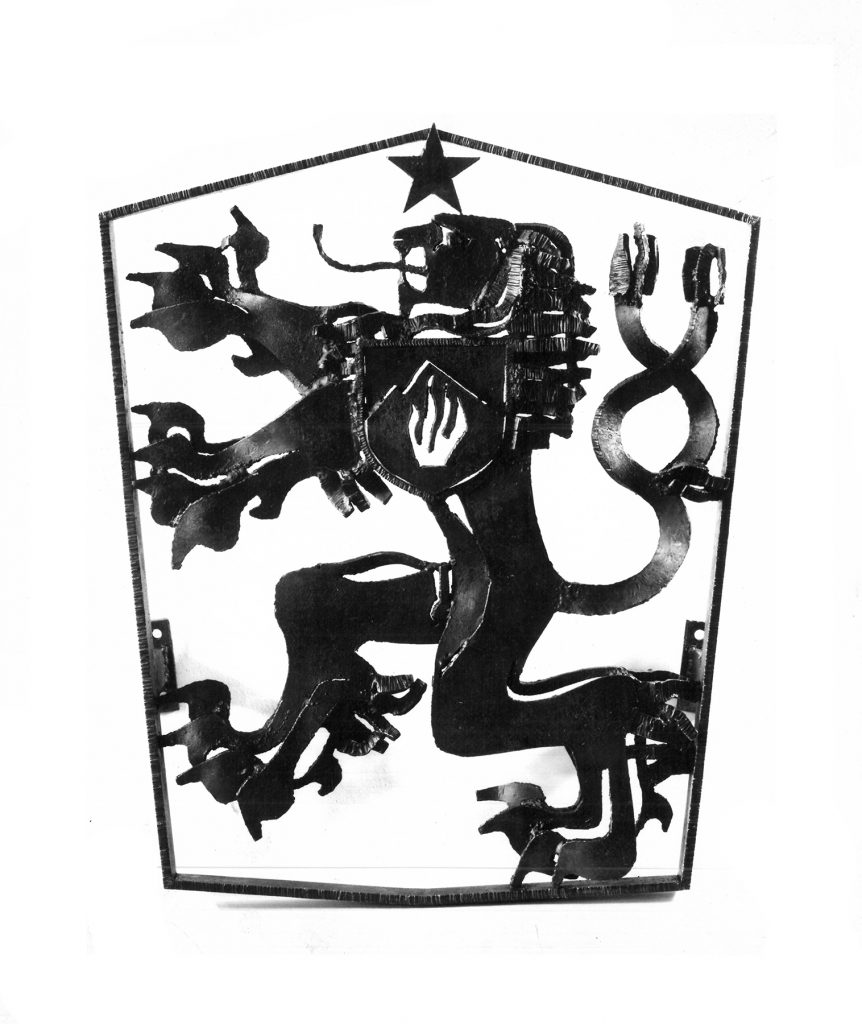
Erna Masarovičová: State emblem of the CSSR. Welded metal. Photo: Erna Masarovičová’s archive
The second most acclaimed expo division, after the thematic Children’s World, was the dreamy or even fanciful Inspiration section created under the authorial guidance of Antonín Kybala. Drawing inspiration from nature, the collective of artists made a spatial composition from textile and jewellery. Graphic designer and illustrator Albín Brunovský was given an unusual opportunity to make a design for “a monumental illustration” – a ceiling fresco entitled Nature. The head of the professional selection committee for jewellery was Stanislav Libenský. As for Slovak artists, the committee chose designer jewels of Anton Cepka, Alina Ferdinanda, Erna Masarovičová and a jewellery box by Jana Cepková. The final section of the exhibition with the title Invitation served as a complex visual invitation to visit Czechoslovakia. Slovakia was represented by photo albums bound by bookbinding craftsman Ján Vrtílek; they were dedicated to the Club of Compatriots.
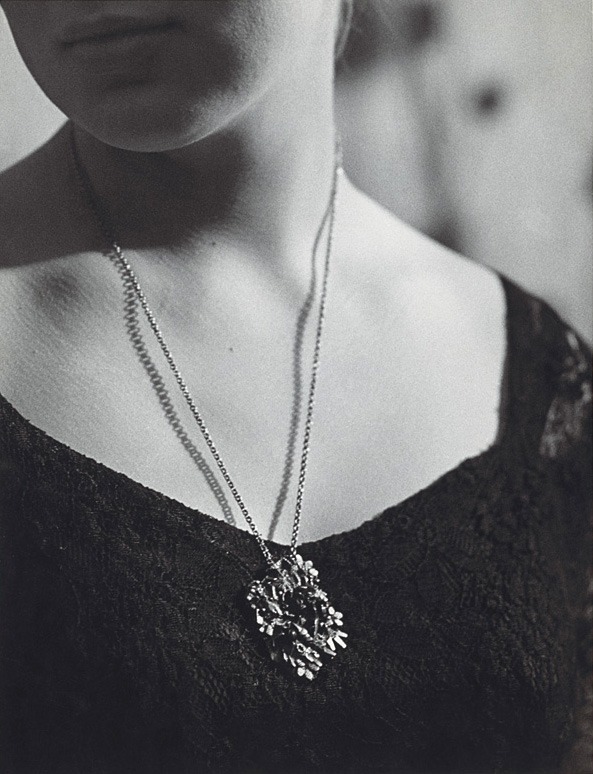
Alina Ferdinandy: Suspension. Around 1965. Photo: Archive of the Slovak National Gallery, Bratislava
Not only was Expo 67 a feast for eyes, it was also an event integrating all human sensory perceptions. Food served as a sensory perception, as a means of communication and a sign of national identity – the presented countries and visitors paid it an extraordinary attention. Therefore, the authors of the stand-alone restaurant pavilion and individual Czechoslovak committees put a considerable emphasis on the aesthetical and utilitarian arrangement of interiors and restaurants.
The walls of the Old Prague’s Restaurant were adorned with the Ladislav Guderna‘s fantasy-like colourful “stucco lustro” with a motive of card games that elaborated on the traditional interest of the Czechoslovak modern art in surrealism. The authors of the interior of the so-called Slovak Restaurant (a correct title is the Bratislava‘s Restaurant or simply Bratislava) were architects Vojtech Vilhan and Ferdinand Milučký. They were inspired by the synthesis of functionalism and elements of the Slovak folk art and architecture. The restaurant interior bore many connotations of folk architecture and art, particularly in utilising wood for furniture, in the tectonics of massive joists and walls made of planks. The dominant feature of the interior was the light inspired by a so-called wedding wreath. One of the artists who took part in the making of the restaurant relief walls was sculptor Vladimír Kompánek. Since both Kompánek and Milučký grew up around Rajec region in central Slovakia, their common surroundings and experiences originating in their childhood and their interest in reforming folk art from the modernist positions was demonstrated in their abstracting, “non-sentimental” view of folk motives. Apart from the relief in the restaurant, Kompánek made a bronze casting called Slovak Bride in front of the entrance.
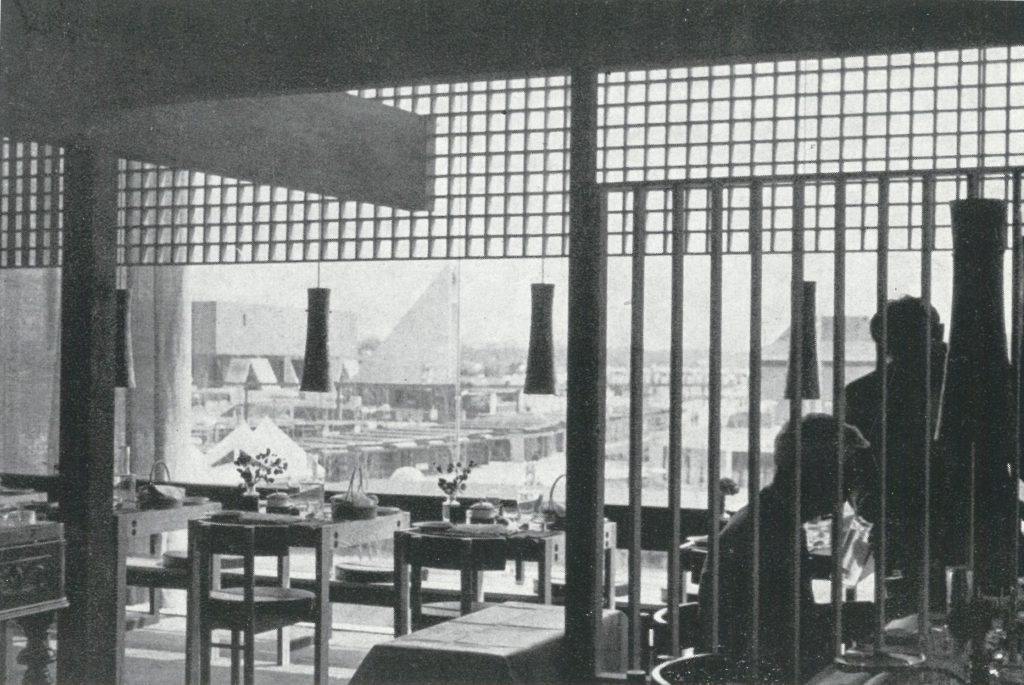
Pavilion of the CSSR Expo 67 Montreal. Interior of the Bratislava Restaurant. Authors: F. Milučký, V. Vilhan. Reproduced by: R. Masný and M. Lojdl: Stavoprojekt Bratislava 1949-1969. Issued Stavoprojekt in Bratislava on the occasion of the 20th anniversary in the Publishing House ROH Práca, Bratislava, 1969

Pavilion of the CSSR Expo 67 Montreal. Interior of the Bratislava Restaurant. Authors: F. Milučký, V. Vilhan. Reproduced by: R. Masný and M. Lojdl: Stavoprojekt Bratislava 1949-1969. Issued Stavoprojekt in Bratislava on the occasion of the 20th anniversary in the Publishing House ROH Práca, Bratislava, 1969
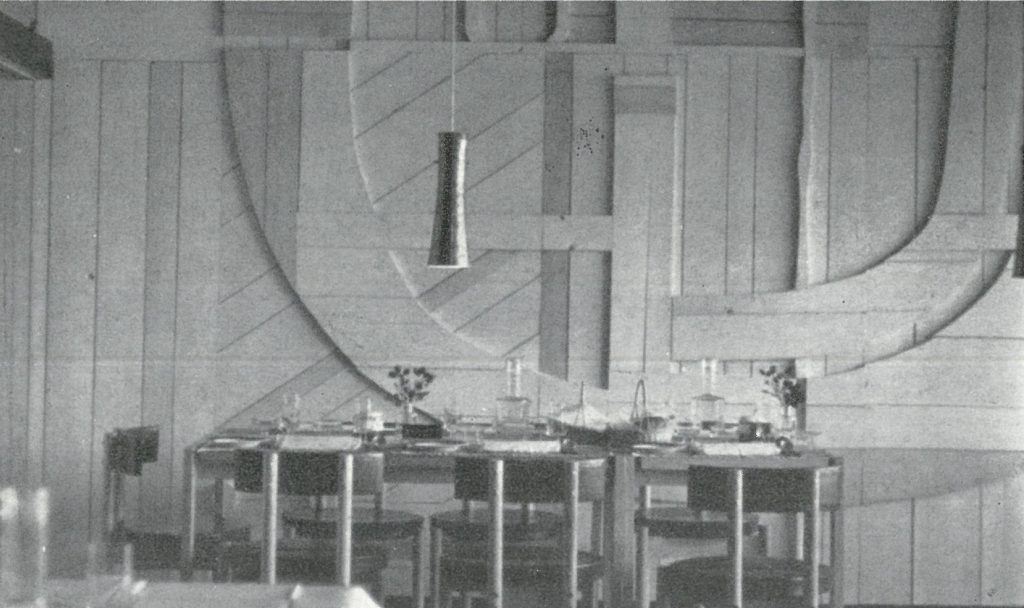
Vladimír Kompánek: Relief Wall in Koliba. Reproduced by: R. Masný and M. Lojdl: Stavoprojekt Bratislava 1949-1969. Issued Stavoprojekt in Bratislava on the occasion of the 20th anniversary in the Publishing House ROH Práca, Bratislava, 1969
Two Slovak state-owned companies supplied the drinkware for two Slovak restaurants, and dinner service and cutlery for all three Czechoslovak restaurants. The then established and progressive design centre of the state-owned company United Glasswork Lednické Rovne led by designer Jaroslav Taraba in cooperation with Karol Hološka manufactured several sets of drinkware characterised by its simple shape and smooth stemware. The Sandrik factory in Dolné Hámre, Ján Čalovka’s place of work, made a collection of about 60 kinds of silver-plated tableware: cutlery and dinner services. Čalovka’s designs built up on functionalism with their nickel silver vs. natural material (cutlery with wooden handles) solution.
Apart from Bratislava, the visitors of the world’s fair could as well visit the very restaurant Koliba (Shepherd’s Hut) that was a result of a winning project of Vojtech Vilhan and Stanislav Talaš. It was located on the St. Helen’s Island in La Ronde, in an entertainment part of Expo full of joyful, playful and humorous atmosphere of merry-go-rounds, restaurants, shooting galleries and other funfair attractions.

Expo 67 Montreal. Slovak restaurant Koliba. Authors: S. Talaš, V. Vilhan; J. Gelinas, M.I.R.A.C. Realization by Janen Montreal and Drevina Turany 1966 – 67. Reproduced by: R. Masný and M. Lojdl: Stavoprojekt Bratislava 1949-1969. Issued Stavoprojekt in Bratislava on the occasion of the 20th anniversary in the Publishing House ROH Práca, Bratislava, 1969
In front of its entrance was a wooden sculpture of a bell tower by Jaroslav Kočiš. The totem-like object on a high pole with circular openings was a reference to wooden folk dovecots. The Koliba architecture embodied a traditional wooden shepherd’s building in a new material and construction interpretation: in combination of wood, metal and other naturе-inspired/natural colourings. Like in case of the Bratislava’s Restaurant, a bold tectonic construction element was a wooden joist passing from the interior to the exterior of the building. Sculptor Jaroslav Kočiš was in charge of its artistic finish. Brass shepherd’s bells were hanging on the joist in the exterior. The Koliba’s interior was separated in accordance with three culturally specific, distinctive regions of Slovakia: northern Ždiar, central Liptov and southern Chorvátsky Grob. The Grob’s section featured the tapestry named Sunday Afternoon (1965) by Mária Rudavská. Architect and designer Viktor Holešťák-Holubár created the lighting objects by putting together elementary geometric shapes made of split spruce, drawing his inspiration from a traditional folk technique called “split doves”. Sculptress Erna Masarovičová contributed to the interior and exterior of Koliba with metal details – several welded objects loosely inspired by folk art. Dagmar Rosůlková authored a prototype of tableware derived from the folk forms of kitchen utensils, transferring and transforming them into traditional Slovak majolica pottery with a top blue and inner white glaze (as a reference to typical Slovak pottery from Modra).
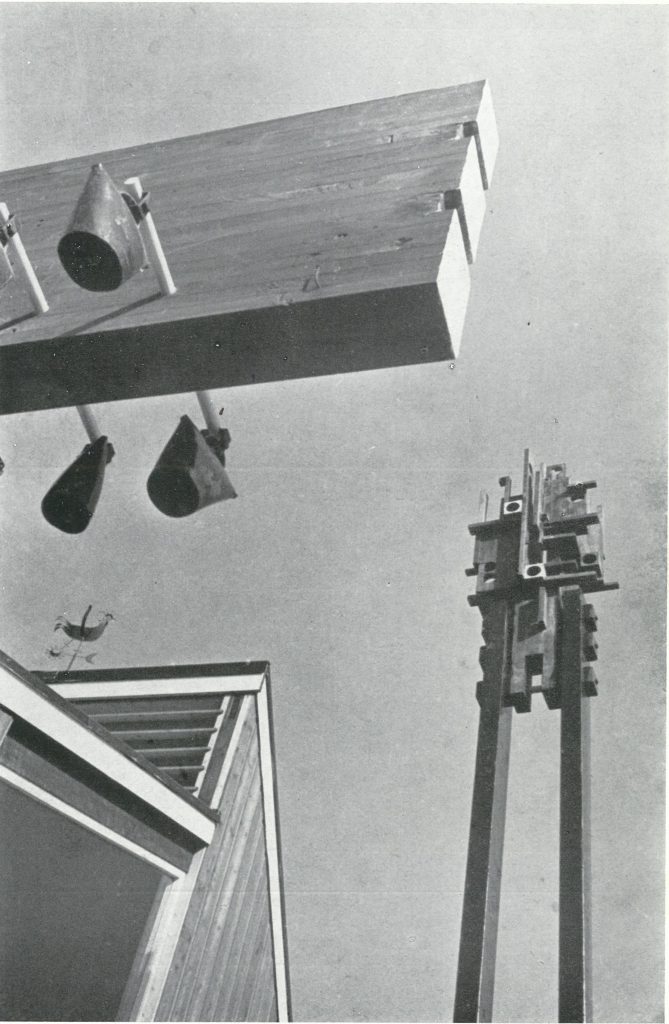
Expo 67 Montreal. Slovak restaurant Koliba. Authors: S. Talaš, V. Vilhan; J. Gelinas, M.I.R.A.C. Realization by Janen Montreal and Drevina Turany 1966 – 67. Reproduced by: R. Masný and M. Lojdl: Stavoprojekt Bratislava 1949-1969. Issued Stavoprojekt in Bratislava on the occasion of the 20th anniversary in the Publishing House ROH Práca, Bratislava, 1969
At the time of social and political détente and liberalisation, art not only followed the pre-war modernism of early avant-garde that treated folk art as a fundamental part of its artistic and spiritual background. Modernism was also reviewed from the point of view of local sources as well as new international artistic impulses. In this respect, the choice of the classic of modern art Ľudovít Fulla, the artists from the Mikuláš Galanda’s group – Laluha and Kompánek –, the non-figurative work of Rudolf Uher, the welded plastic art of Erna Masarovičová and the totemic object of young sculptor, graphic designer and painter Jaroslav Kočiš can be understood as a democratically pluralist and balanced representation of various approaches to art that presented a new thought emerging from both national and international sources. Even though this approach may seem too conventional and binding, world’s fairs wanted to present these national specific features. From this viewpoint, the strategy of choice of the works of art and architecture seems to be clearly pronounced and authentically selected without being succumbed merely to bringing out folklore sentiment and “striking the folk chord”.
Vladimíra Büngerová
An overview of the Slovak participation in Expo 67 in Montreal was put together based on the published study: Büngerová, Vladimíra: Shepherd’s Hut on the Island. The Slovak Participation in Expo 67 in Montreal. In: Nekvindová, Terezie a Kramerová, Daniela (ed.): Exhibition Machine. The Czechoslovak Pavilion in EXPO 67 in Montreal. Published by The Art Gallery in Cheb and The Academy of Fine Arts in Prague in 2017).
[1]
The exhibition Brussels Dream. Czechoslovak Participation in the EXPO 58 in Brussels and Lifestyle of the First Half of the 1960s and its eponymous publication were prepared in 2008 – 2009 (The Prague City Gallery, Prague; The Moravian Gallery, Brno; The Slovak National Gallery, Bratislava) and curated by Daniela Kramerová and Vanda Skálová.
[2]
Automat na výstavu. Československý pavilon na EXPO 67 v Montrealu. The editors of the eponymous publication are Terezie Nekvindová a Daniela Kramerová, published by The Art Gallery in Cheb and The Academy of Fine Arts in Prague in 2017.
[3]
Nekvindová, Terezie: Výstava versus výstavnictví. Československé pavilony na Expo 1967 v Montrealu a Expo 1970 v Ósace. Univerzita Karlova v Praze, Filozofická fakulta, Ústav pro dějiny umění, Praha, 2014. (Exhibition vs. exhibition practice. The Czechoslovak Pavilions at Expo 1967 in Montreal and at Expo 1970 in Osaka.)